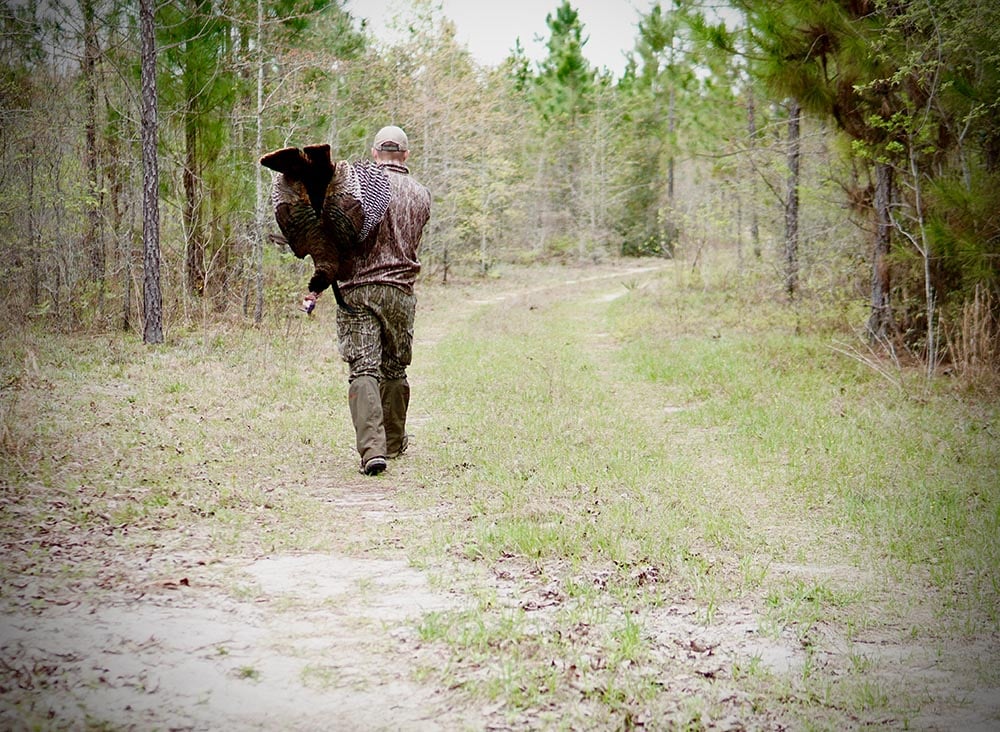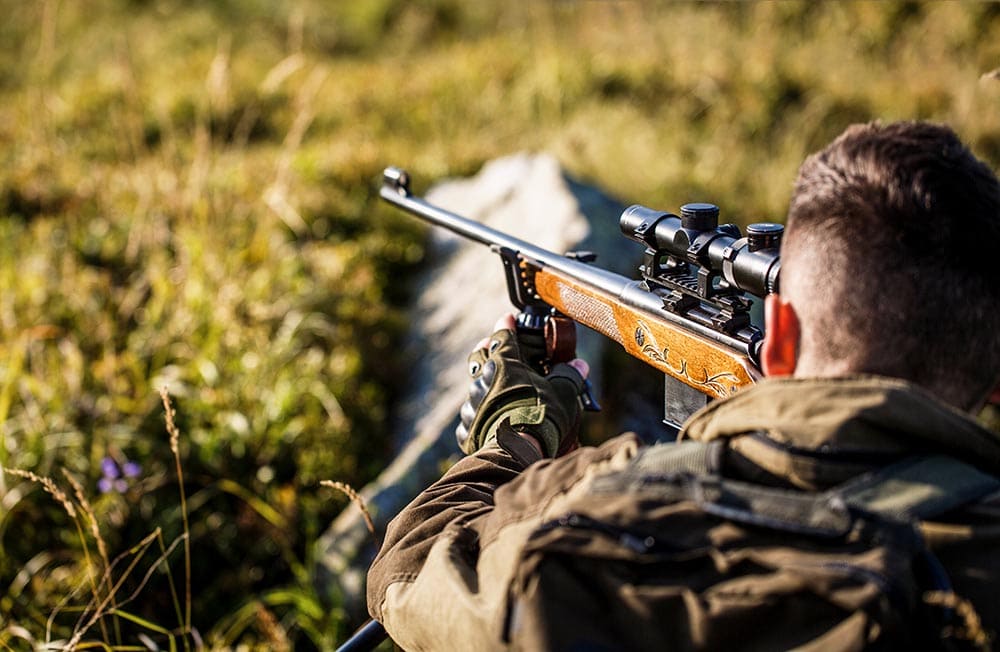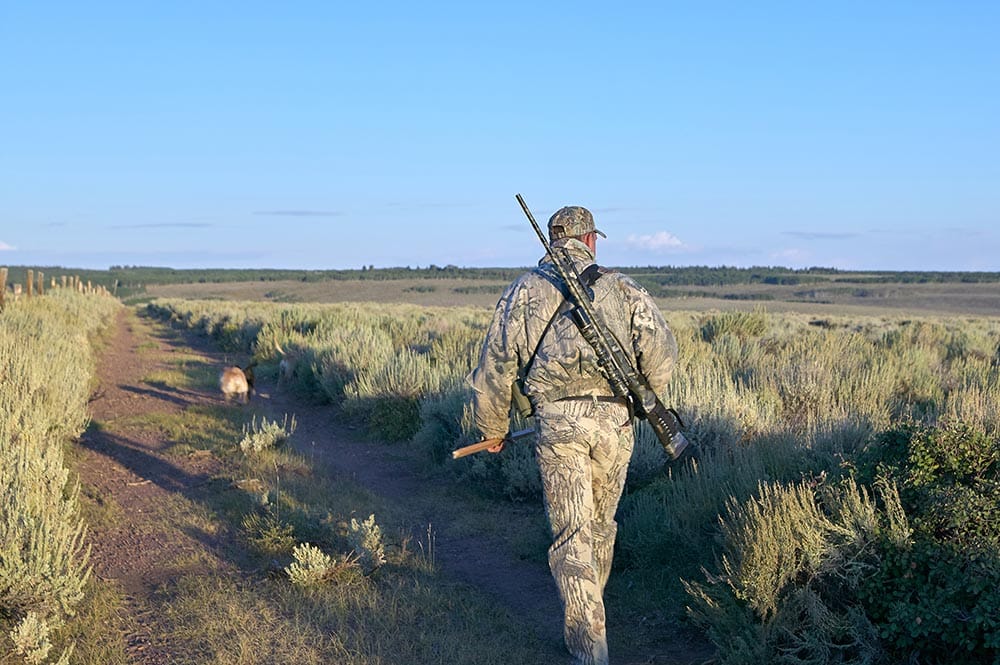How to Turkey Hunt — 15 Basic Tips & Tricks
Last Updated on

When autumn rolls around, a favorite activity of hunters is going after a few gobblers. If you really want to enjoy the season, following a few basic tips and tricks can greatly increase your chances of success.

How to Turkey Hunt – 15 Basic Tips & Tricks for a Succesful Hunt
If you want a successful turkey hunt, follow as many of these recommendations as possible. Remember, it is all about staying the course and outwitting a tom!
1. Stay Patient

Too many turkey hunters lose a bird because they do not stay still long enough when they start calling, or they start calling too often once they pick a spot. They want a bird and they want it now.
Getting a gobbler is all about playing the long game, which means staying patient even when the pressure ramps up.
2. Get Out There Early
You can be too late to a turkey hunt, but you can’t be too early. Once you have the perfect spot staked out, arrive there early. If you think that you should be there at 4 in the morning, get there at 3. It can be the difference between a successful and quick hunt in the morning and a long unsuccessful one that takes the entire day.
3. Have Backup Calls on Hand
Sometimes all your favorite calls just aren’t working. You shouldn’t be afraid to mix things up, and the only way you can do that is if you have multiple calls with you. Have at least one backup call in case your primary isn’t working.
4. Play Hard to Get
When you’re hunting for a tom, you need to make him think that he’s working for the hen. Once he gets close, let him gobble twice before calling back. Ideally, he already knows where you are, and you don’t have to call again at all.
But by working him up, you’re lowering his guard a bit, making it more likely that he’ll think that you’re a real hen and not a hunter.
5. Get as Close as Possible

The closer that you can get to the gobbler without having to call them in, the higher your chance of success. Get as close as you can without the gobbler seeing you, set up, and then make your call. The smaller the distance the gobbler has to travel, the more likely that you’ll bag him.
6. Get the Cadence Right
Using the right noise is important, but turkeys are well-tuned to the cadence behind a call. Getting the cadence right is the only way to fool a tom into thinking that you’re a hen. Listen for a while to the natural cadence of calls, and then match them as close as you can.
7. Set Up the Decoys Correctly

There’s a great deal of noise out there about getting the fanciest decoys possible. There are decoys that make noise, move, and do all sorts of stuff. Skip all of it — instead, focus on setting it up in the right location.
You need to put it where the gobbler will pass you to get to the decoy. That way, you can take a shot just 10 to 15 yards out. Don’t worry about all the extra features; just focus on getting the location right for a successful hunt.
8. Funnel Your Calls
The tom won’t come if he can’t hear your calls, and one of the best ways to increase your chances that he hears the call is to funnel the noise toward them. Hold your call away from your body, and point it toward the area with the tom.
This enables the noise to travel farther and greatly increases the chances that he’ll come running in response.
9. Use Binoculars
One of the most important tools in your turkey-hunting tool belt is a pair of 10x binoculars. Turkeys can see farther through the vegetation than you can, so giving yourself a pair of binoculars helps even things out for you.
They’re not that expensive and can be the difference between getting a gobbler and wasting your time for a few days in the woods.
10. Know How to Track Them

If you can identify turkey tracks and droppings, it’s easier to find out where they’re at. Gobblers have a middle toe print that’s about 2.5 inches long, and their droppings are large with a fishhook appearance and a splash of white.
11. Keep an Eye on the Curve
If you’re looking for a great place to set up, look for a curve in a road. Toms love heading right out the curve so they can look both ways for the hen. It also puts them in plain sight for a shot, making it the perfect location to stake out.
12. Don’t Call More Than You Need To
A common rookie mistake is calling more often than you need to. While calling is a way to bring in a turkey, it also increases the chance that a tom will spot you. If they see you making the calls, they’re gone. So, call only as much as you need to, so the tom is hunting for the hen and isn’t able to spot you.
13. Mock the Hen
Sometimes all you need to do to get a tom is to attract the hen. If your gobbler has a bossy female following him around, mock all her calls when she does them. This will attract her, and where she goes, the tom will follow. So, mock the hen and bring in the tom!
14. Prepare Your Shot Beforehand

The last thing that you want to do when you have a tom in your sights is to have to reposition and scare him off. If you hear him coming up from a certain direction, slide that way, raise your shotgun, and get ready. That way, when he’s in range, you don’t have to move much to make your shot.
15. Don’t Miss!
It probably goes without saying, but you only get one chance to get your gobbler. If you miss, he’s going to fly off, and he’s not coming back. Ensure that when you pull the trigger, you’re getting your gobbler; otherwise, you might as well head home and try again somewhere else the next day.

Final Thoughts
When you head out in the morning, you want to bring home a turkey. Hopefully, now that you know a few basic tips and tricks, you can bring home a tom the next time that you head out and enjoy turkey legs for dinner!
Featured Image Credit: Beau Leyse, Shutterstock
Table of Contents
- How to Turkey Hunt – 15 Basic Tips & Tricks for a Succesful Hunt
- 1. Stay Patient
- 2. Get Out There Early
- 3. Have Backup Calls on Hand
- 4. Play Hard to Get
- 5. Get as Close as Possible
- 6. Get the Cadence Right
- 7. Set Up the Decoys Correctly
- 8. Funnel Your Calls
- 9. Use Binoculars
- 10. Know How to Track Them
- 11. Keep an Eye on the Curve
- 12. Don’t Call More Than You Need To
- 13. Mock the Hen
- 14. Prepare Your Shot Beforehand
- 15. Don’t Miss!
- Final Thoughts
About the Author Robert Sparks
Robert’s obsession with all things optical started early in life, when his optician father would bring home prototypes for Robert to play with. Nowadays, Robert is dedicated to helping others find the right optics for their needs. His hobbies include astronomy, astrophysics, and model building. Originally from Newark, NJ, he resides in Santa Fe, New Mexico, where the nighttime skies are filled with glittering stars.
Related Articles:
How to Collimate Binoculars: 9 Expert Tips
How to Clean a Rifle Scope: 8 Expert Tips
How to Choose Binoculars for Bird Watching: 10 Expert Tips
10 Types of Hummingbirds in Arkansas (With Pictures)
8 Types of Hummingbirds in Nebraska (With Pictures)
5 Types of Hummingbirds in Idaho (With Pictures)
3 Types of Hummingbirds in Mississippi (With Pictures)
8 Types of Hummingbirds in Kansas (With Pictures)
